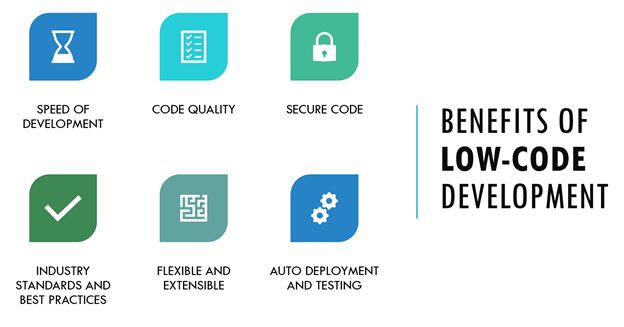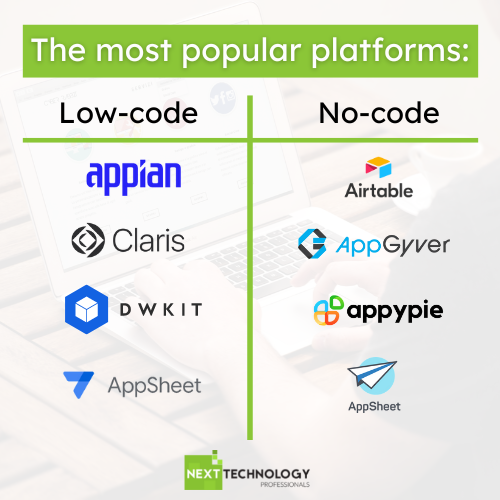Recommended Reasons For Selecting Legacy application modernization with Low-code
Wiki Article
Benefits Of Low-Code Application Development With Regard To Accessibility For Non-Developers
Low-code apps improve accessibility for non-developers (often referred to "citizen-developers") due to several key elements.
Drag-and-Drop Builders: Low-code systems have drag-and-drop interfaces, which allow non-developers, who do not need to write code, to develop visually appealing applications. This makes it easier for people who don't have technical backgrounds to get involved in the process of development.
WYSIWYG editor: The "What you see is the result you get" editors allow users to create interfaces, workflows, and other functions in a manner which closely resembles the final outcome. They are easier to learn and make use of.
Simple Workflow and Logic Design:
Visual Workflow modeling: Users create business flows and application logic with visual flowcharts. The models are easier to work with than traditional codes.
Pre-built Logical Components: A lot of low-code platforms come with pre-built components for logic (e.g. conditions, loops) which can be easily configured. This eliminates the need to code complex programs.
Reusable templates and components:
Library of Pre-built Templates: Many low-code platforms offer templates for the most common types of applications which allow non-developers to start from a solid base and modify as they need to.
Reusable Widgets And Modules: Users can make use of reusable widgets. This makes it easier to create and eliminates the requirement for deep understanding.
Guided Development and Tutorials
Step-by-Step Guides: Platforms frequently provide guided development pathways or online tutorials on-screen directions to help those who are not developers in developing applications.
Interactive Tutorials. Interactive, hands-on tutorials let users gain knowledge by doing.
Integration with tools already in use
seamless integration: Low-code platform are designed to be integrated seamlessly with the existing systems, tools, as well as software (e.g. ERP and CRM). This enables non-developers who do not have a background in programming to build applications that work with their existing workflows.
APIs/Connectors: These APIs/Connectors enable non-developers to connect their apps to external services.
Collaboration Features:
Team Collaboration: Features, such as real-time collaboration and shared workspaces, enable non-developers and professionals to work together effectively.
Access Control Based on Roles: Non-developers can have access to roles and levels of access that allow their participation without compromising security or functionality.
Automated testing and debugging:
Low-code platforms are usually equipped with testing and debugging software that can automatize these processes. This makes it easier for non-developers to check their applications work correctly.
Error highlighting: The platform highlights issues and suggests fixes to help non-developers.
Development using low-code is more accessible to non-developers because it allows for democratization of the development process. Low-code platforms are easy to use visual tools, guided experiences and enable business users actively participate in creating, maintaining and updating applications. Take a look at the most popular Low-code Platform for application development hints for blog recommendations including mobile development platforms, app platforms, paas service, app modernization, cross platform app dev, app modernisation, cross platform mobile development, build a docker container, rapid application design, cloud software applications and more.

Low-Code Software Is Cost-Effective.
Low-code app development offers many advantages, including cost-effectiveness. This is an appealing alternative for companies looking to optimize development budgets without compromising on quality. The main advantages:
The low-code platform makes it less necessary to write extensive manual coding. This means less time and effort on the part of developers while developing their applications. This translates into lower costs for labor.
Reduced Developer Resources: Because low-code is quicker and easier to create, less skilled developers will be needed. This can drastically reduce the need for costs for hiring and staffing.
Quicker time to market:
Accelerated cycle of development Visual tools for development as well as pre-built parts provided by platforms with low-code support rapid application development, allowing companies to get their products on the market quicker. This will result in faster revenue growth and improved positioning in the market.
Rapid Prototyping - Businesses can create prototypes and test them in a short period of time, which can reduce the time required for the development phase. This allows them to create faster the next iteration after receiving feedback from users.
Low Maintenance Costs
Simpler Maintenance: Low-code platforms with their modular components and standardised components make them easier to maintain. This can reduce the expense of ongoing maintenance and support.
Automated updates: A lot of low code platforms automatically handle updates and patches, ensuring that applications are secure and up-to-date with no need for manual intervention.
Efficient Resource Utilization:
Contributions from non-developers Low-code platforms allow business users and non-developers alike to participate in the process of development. This lets employees and businesses cooperate, and reduces the dependency on high-paid developers.
Improved utilization of IT resources IT departments get the opportunity to focus on more strategic projects, instead of getting bogged down with routine development tasks. Overall efficiency and productivity are increased.
Pricing models that can be scaled:
Subscription-based Prices: Many lowcode platforms are flexible and have subscription-based pricing plans that rise in line with usage. This lets companies adjust their budgets to meet their requirements and needs without having to pay large upfront costs.
Pay-As-You-Go options - Some platforms allow companies to pay for only the amount they spend. This is especially beneficial for small or start-up companies with limited funds.
Reduced Third-Party Software Costs:
Built-in Functionalities: Low-code platforms usually come with built-in functionalities and integrations that minimize the requirement for third-party software and tools leading to savings on licensing fees and subscription fees.
Pre-Built integrations: These systems and services can be integrated with popular services, which reduces the need for custom-developed software and saves both time and cost.
Increased ROI:
More efficient return on investment (ROI) Through the combination of rapid development, lower costs and a shorter time to the market, businesses can achieve an increased ROI on their apps.
Increased agility. Businesses can quickly adapt the demands of customers and market trends to ensure they are relevant. They can also profit from new business opportunities when they occur.
Lower Training Costs:
Low-Code Platforms have User-Friendly Interfaces. The intuitive and user-friendly interfaces help ease the learning curve of new users. This reduces the requirement for extensive training programs.
Accessible Resources: Many platforms using low-code provide an extensive range of instructional materials, tutorials, and support for community members. This reduces the requirement for formal education as well as the expenses associated with it.
Collaboration Streamlined:
Collaboration Tools: Collaboration tools integrated aid in coordination and communication within teams, resulting in improved processes for development, and less overhead.
Unified Development Environment: A single, unified development environment helps streamline workflows and reduces the cost and complexity of managing multiple tools and platforms.
Overall, the cost effectiveness of software development using low-code can be attributed to its ability to lower the cost of maintenance and development as well as increase the time to market, optimize resource use, and provide flexible price models. These aspects provide significant financial rewards to businesses. Low-code is a great option for companies that wish to make the most of their budgets, but also build robust, scalable, and top-quality software. Check out the best this post about Legacy application modernization with Low-code for more info including low code platforms, develop cross platform mobile app, push notifications android, cross platform app dev, microsoft azure sql, no code platforms, azure sql, develop web app, application development platforms, azure sql and more.

Benefits Of Low-Code Application Development In Terms Of The Limitations And Customization
Low-code development provides an unbiased approach to dealing with the limitations of the system, while also providing the possibility of customizing. These are the major advantages: Managing the limitations
: .
Low-code platforms facilitate development by providing templates that are pre-built and other components. This allows faster deployment and development of complicated applications.
Guided Workflows: Several platforms provide guided workflows and wizards that help developers navigate through complicated processes, reducing the chance of making mistakes and ensuring consistency.
Scalability Solutions:
Scalability is built into low-code platforms. They usually come with capabilities that permit scaling architecture. This enables applications to handle higher loads without requiring major redevelopment.
Performance Monitoring: Integrating instruments for monitoring performance, optimization and tuning assist applications to scale effectively.
Security and Compliance
Security features integrated into Low-code platform comes with built-in measures of security, such as encryption. Access control that is based on roles and automated compliance check to address the most prevalent security concerns.
Regular Updates: Platforms regularly change their security protocols as well as compliance measures, ensuring that applications remain secure against new threats.
Customization:
Extensibility:
Low-code platforms can often be able to incorporate custom code, such as JavaScript or Python, allowing developers to expand their capabilities beyond what is standard.
Developers are able to create custom modules and plugins which add features that are that are tailored to the specific requirements of a business.
APIs & Integration:
API Support: A full API support is provided to allow seamless integration and connection with external systems.
Third-Party Services : Low-code platform often provides pre-built connections for well-known services offered by third parties making integration and customizing simpler.
Flexible Design of UI/UX:
User interfaces that can be customized: Developers can modify and design the user interfaces in order to satisfy specific branding requirements and usability needs, providing the user with a customized experience.
Responsive Web Design: Built-in design responsive capabilities allow applications to be customized depending on the device and screen size.
Custom Business Logic:
Visual Workflow Designers: These visual tools are used to customize and create workflows and business logic, which allows developers to develop complex, custom-designed processes.
Conditional Logic and Scripting: Platforms enable the integration of conditional logic as well as custom scripting that can handle certain business rules and scenarios.
Data Management
Custom Data Models: Developers may develop custom data models that suit specific application needs and ensure that data handling is tailored to business requirements.
Advanced Data Processing: Integration of advanced data processing capabilities and tools allow for customization of the way data is processed within an application.
Customisation and balancing limits:
Frameworks and Standards
Best Practices Compliance Low-code platforms promote the use of industry-leading practices and standards, which assists in maintaining high-quality scalable, and secure applications.
Governance Frameworks Inbuilt governance frameworks will ensure that the customizations don't compromise the integrity, security or security of the software.
Iterative Development and Feedback
Rapid Prototyping: The ability to rapidly prototype and test changes allows developers to iterate based on user feedback and refine the application to meet the needs of users.
Continuous Improvement: Low code platforms permit continuous improvements. They are able to be modified and customized when business requirements change.
User Empowerment
Giving Citizen Developers the tools they need by allowing non-developers to customize their applications using simple interfaces, low-code platforms broaden the number of users who can customize and enhance applications.
Training and Support: A lot of platforms offer comprehensive training and support to help users make effective customizations without compromising the stability of the application, or its performance.
Overall, application development that is low-code gives a strong framework to overcome limitations while providing ample opportunities for customization. This allows companies to develop and maintain applications that function as well as tailored to the specific needs of business. While maintaining security, quality, scalability, and standards.
![]()